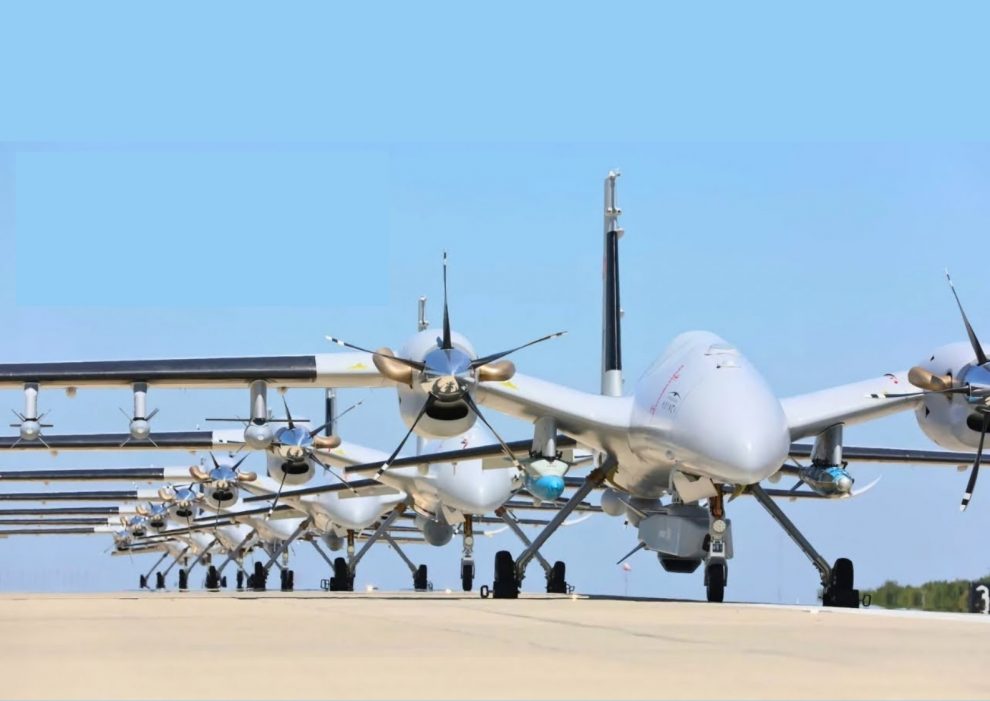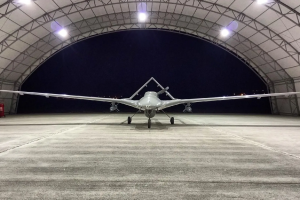Through innovation and strategic foresight, Turkey has evolved from relying on foreign military imports to becoming a global powerhouse in drone technology.
In just two decades, Turkey has transitioned from being dependent on foreign military imports to a self-reliant leader in global drone technology. Visionary engineers like Selçuk Bayraktar have driven this transformation, creating cutting-edge systems such as the Bayraktar TB2, a cost-effective drone now used worldwide. With innovations in AI, stealth, and next-generation drone technologies, Turkey is solidifying its position as a pioneering force in modern military advancements.
The 21st century has highlighted two pivotal technologies in military aviation: drones and stealth capabilities. While basic drones are produced by many nations, large missile-carrying drones and military aircraft with very low radar signatures have traditionally been exclusive to major powers such as the United States, China, and Russia. However, this dynamic is shifting.
The remarkable performance of Turkish Bayraktar drones, utilized by Ukrainian forces in the ongoing European conflict, has captured global attention. Once referred to as the “sick man of Europe,” Turkey has astonished the world by quietly amassing the largest arsenal of armed drones, surpassing even the United States, China, and Israel. Turkey’s rise as a global leader in the drone industry has been nothing short of extraordinary, with its impact felt from the battlefields of Ukraine to the shifting geopolitical landscapes of the Middle East.
The Evolution of Turkey’s Drone Industry
Turkey’s journey to drone supremacy began in the 1990s, with a controversial attempt to acquire Heron UAVs from Israel. The deal came with an insulting stipulation: Israeli pilots would operate the drones. This affront spurred Turkey to achieve self-reliance in military drone technology. Over the following decades, the country focused on developing its own unmanned aerial vehicles (UAVs), initially for reconnaissance and surveillance, before embarking on more ambitious plans.
In the early 2000s, the Turkish government launched a comprehensive strategy to modernize its defense industry, aiming for self-sufficiency. By the 2020s, Turkey had become a dominant player in the global drone market. According to the US-based Center for a New American Security (CNAS), Turkey now accounts for 65% of the world’s military drones, followed by China at 26% and the US at just 8%.
Bayraktar TB2: The Game-Changer
At the forefront of Turkey’s drone revolution is the Bayraktar TB2, developed by Baykar Technologies. This medium-altitude, long-endurance armed drone has a wingspan of 40 feet, a maximum altitude of 22,000 feet, and can remain airborne for up to 27 hours. It carries precision-guided munitions, such as the MAM-L and MAM-C, capable of destroying a range of targets with minimal collateral damage. Advanced sensors and autopilot systems enable the TB2 to operate autonomously, making it a formidable force in modern warfare.
The TB2 has proven its effectiveness in various conflicts, from the Nagorno-Karabakh war between Azerbaijan and Armenia in 2020 to the ongoing conflict in Ukraine. Videos of TB2 strikes on Russian military targets have gone viral, showcasing its battlefield success and bolstering its reputation as a reliable weapon system.
Expanding the Arsenal
Turkey’s drone capabilities extend beyond the TB2. Other notable platforms include:
- Anka-S: Developed by Turkish Aerospace Industries (TAI), this drone has a wingspan of 55 feet, operates at altitudes of up to 30,000 feet, and carries a payload of 440 pounds. It is equipped with radar and ground-moving target indicator systems, making it a high-altitude alternative to the TB2.
- VESTEL Karayel: This drone offers a balance of performance and cost-effectiveness, with a payload capacity of 374 pounds and an operational ceiling of 18,000 feet.
These drones, combined with Turkey’s focus on affordability, firepower, and reliability, have made Turkish UAVs highly sought after globally.
A Global Strategy
Turkey has used its drone technology as a tool for foreign policy, forging stronger ties with countries like Azerbaijan, Qatar, and Ukraine, as well as new relationships with nations such as Poland, Saudi Arabia, and Tunisia. The Atlantic Council highlights that Turkey’s arms sales, particularly drones, have significantly enhanced its international influence.
Challenges and the Future
Despite its successes, Turkey’s rise in the drone market has not been without controversy. Critics, including human rights organizations, have raised concerns about civilian casualties in conflicts like Libya and Nagorno-Karabakh. NATO allies have also expressed unease about the proliferation of advanced military technology.
Looking ahead, Turkey is investing in next-generation UAVs, including stealth drones and autonomous swarm systems, ensuring its continued leadership in the field. However, competition from the United States, China, and Israel is intensifying, signaling a potential arms race in drone technology.
For now, Turkey stands as the undisputed leader in military drones, with its innovations shaping modern warfare and redefining geopolitical power dynamics.
A revolution is underway, but it’s not originating from where you might expect—not from the United States or the West. Instead, this transformation is taking place in Turkey, a country that, just two decades ago, struggled to produce its own military equipment. Today, Turkey has built one of the world’s largest fleets of armed drones, turning a rejected engineer’s dream into a global military powerhouse.
In 2005, 26-year-old engineering graduate Selçuk Bayraktar approached Turkish military officials with a vision for advanced drones. His proposal was met with skepticism and rejection. At the time, Turkey heavily relied on foreign weapons systems, spending billions annually on imports. Competing with established drone manufacturers seemed unrealistic, if not delusional.
Yet today, Turkish-made drones are transforming modern warfare, with over 35 countries integrating them into their military forces. These drones have been critical in conflicts ranging from Libya to Ukraine. The story of this meteoric rise begins in 2003, when newly elected Prime Minister Recep Tayyip Erdoğan announced plans to end Turkey’s dependence on foreign arms by developing a domestic defense industry.
At that time, Turkey’s defense sector was underdeveloped, with limited technological capabilities and no experience in advanced military systems. Enter Selçuk Bayraktar, a young engineer with a master’s degree from the University of Pennsylvania. While studying in the U.S., Bayraktar developed a groundbreaking algorithm enabling unmanned helicopters to land on rugged terrain—even vertically on walls. Although accepted into MIT’s doctorate program, he returned to Turkey to join his family’s automotive parts business, Baykar, with a vision to revolutionize it.
The results surpassed even the most optimistic predictions. By 2022, Turkey’s drone exports exceeded $4.4 billion, surpassing the defense budgets of some European countries. The Bayraktar TB2 drone, known for its affordability and effectiveness, became a household name in military circles. Each unit costs between $5 million and $8 million, significantly undercutting the $32 million price tag of the U.S.-made Reaper drone.
When Western countries restricted component exports to Turkey, Turkish engineers saw it as an opportunity. They began developing indigenous solutions for engines, electronics, and more, creating a self-sufficient drone manufacturing ecosystem. This innovation allowed Turkey to scale quickly.
The TB2 proved its worth in combat, particularly in Syria, Libya, and Ukraine, where it demonstrated remarkable effectiveness against modern air defense systems and armored vehicles. Videos of these operations shared on social media became a potent marketing tool, showcasing Turkey’s capabilities to the world.
But Turkey’s ambitions go beyond the TB2. Near Istanbul, engineers are developing next-generation drones, such as the Bayraktar TB3, designed for naval operations, and the Kızılelma, Turkey’s first unmanned stealth fighter jet. These advancements mark Turkey’s entry into fifth-generation military aviation technology.
Behind this progress is a new generation of engineers, with Turkey’s drone development teams averaging under 35 years old. The industry employs over 100,000 people directly and indirectly, contributing billions to export revenues. In 2023, Turkey signed a $4 billion deal to manufacture drones in Saudi Arabia, further solidifying its position as a global leader.
However, success comes with challenges. Concerns about drone proliferation and autonomous weapons have drawn criticism from human rights organizations. Turkish officials, however, maintain that their programs adhere to international arms treaties and focus on defense.
Looking ahead, Turkey is working on groundbreaking technologies like swarm drones, where multiple units operate as a synchronized system, and AI integration, enabling drones to make real-time tactical decisions. Advances in propulsion systems aim to extend flight times, while stealth technology developments will enable drones to operate in contested airspace.
Turkey’s drone technology is also finding civilian applications in agriculture, urban planning, and disaster management, showcasing the industry’s versatility. This success has sparked a broader technological renaissance in Turkey, with startups in robotics, AI, and materials science flourishing.
While opportunities abound, challenges remain. The global market for military drones is expected to reach $33 billion by 2027, and Turkey faces stiff competition from traditional powers and emerging manufacturers. Maintaining its edge will require continued innovation and adaptation.
The story of Turkey’s drone revolution is not just about military achievement—it’s a testament to vision, determination, and innovation. What began as one engineer’s rejected proposal has transformed Turkey into a major global player in one of the 21st century’s most critical technologies.






